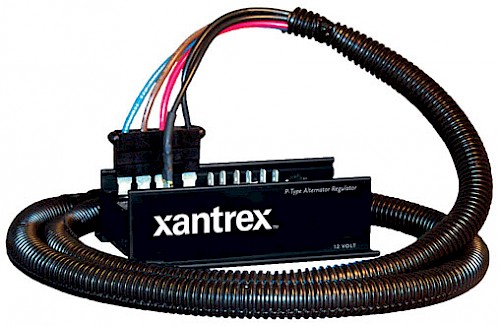
Upgrading to a High Output Alternator?
Question:
I want to replace the alternator in an ocean-cruising Beneteau 40. The engine is a four-cylinder Volvo, Model D2-55. The alternator has to handle a 700 amp-hour battery bank, using a NextStep regulator. What size and model of alternator(s) should I consider? My Volvo has a V-belt, the current alternator is a 120-amp Bosch (installed in Australia a few years ago), and the batteries are AGM. To clarify a bit, I am asking this question for a brother-in-law and sister-in-law who are on their 40-foot sailboat in the South Pacific. Their current alternator is working OK, but they want to obtain a properly-sized spare.
Answer:
Hi Jim,
The V-Belt can handle only up to a 90 amp alternator without dusting or heating, while the serpentine belt can handle much more and is a better choice. A flooded battery can handle 25% of capacity, while an AGM battery can handle 40% of capacity.
There are two possible solutions to your question:
1. Switching to the serpentine belt system
I would suggest getting a second alternator instead of replacing your current one; there is no point in removing the current capacity you already have. Volvo makes a second alternator kit for this engine. They also make a kit that converts V-belt to serpentine. I'd suggest switching to the serpentine belt system.
Installing another 115 amp alternator on your second alternator kit is the right approach. Both of your alternators will have a combined output of 230A. This value is certainly higher than 25% of the maximum charge rate for a flooded battery (700 Ahr). However, this means your alternators won't be running at full capacity and can potentially burn out prematurely. Consider getting a regulator which senses the alternator temperature, that way you can prevent your alternator from working too hard. Also, note that Volvo engines are quite particular in their alarm systems and a smart regulator installation will not be a simple project. You'll need to do a few extra steps not discussed in any manual to avoid your engine charge alarm to turn on when it should not.
2. Staying with the V-belt system
If you stay with the current V-belt system and do not upgrade to serpentine belt, then there maximum alternator should be around 90 amps, but 115 amps might work if the tension is just right on the belt. Through experience (with external regulators), they should know if it experiences dusting. I would suggest getting a hot-rated alternator that is wounded for high output at a low RPM. Both Balmar and ElectroMaax offer these types of alternators. Also, it might be worth considering a regulator that throttles back the field voltage (I.e. the driving force) so that the alternator does not work at maximum capacity (e.g. 70% or 80%) in the event of dusting.
Related Content






 $49.98
$49.98 $35.09
$35.09


























